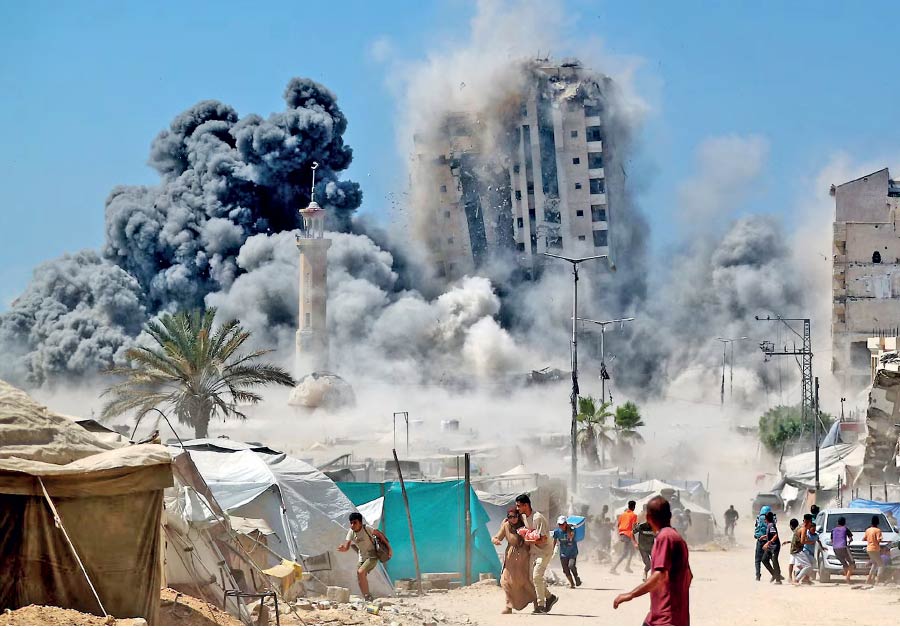Saturday Dec 27, 2025
Saturday Dec 27, 2025
Thursday, 18 September 2025 00:36 - - {{hitsCtrl.values.hits}}

Mushtaha Tower in Gaza City destroyed by Israeli fire on 5 September 2025 – Photo by Mahmoud Issa/Reuters
 The Mushtaha residential tower stands tall next to a sea of tents in the West of Gaza City. A guided bomb from an Israeli military jet hits its base, throwing debris, dust, and a cloud of ashen hell into the air. While the video captures the air barely clearing, and even as we get a glimpse of the building still managing to stand, a second bomb hits. The Mushtaha tower comes down on itself in an explosion that rattles the earth.
The Mushtaha residential tower stands tall next to a sea of tents in the West of Gaza City. A guided bomb from an Israeli military jet hits its base, throwing debris, dust, and a cloud of ashen hell into the air. While the video captures the air barely clearing, and even as we get a glimpse of the building still managing to stand, a second bomb hits. The Mushtaha tower comes down on itself in an explosion that rattles the earth.
There have been mice inside the tower, and insects. Cockroaches and their ilk. These insignificant creatures stand no chance as the world literally collapses around them. With no one to explain what is happening, no one around to evacuate them, the mice and the cockroaches die in their hundreds and thousands, and the former tower becomes their tomb.
The Mushtaha is not the first residential building to crumble upon its residents in Gaza. We know it was not the last, and the way things are going, it seems many more will meet the same fate. But I know something that those who bring these buildings down do not seem to know, for I have seen the videos. Many videos, every day. It is not just mice and cockroaches that live in Gaza.
Therefore, heed my advice, O Israeli soldier: be gentle with that trigger, for there are humans in Gaza.
There are humans in Gaza, living inside those very buildings, like Abu Salah Khalil and his family that lived in the Mushtaha tower. As reported by Al Jazeera last week, until they received evacuation orders just 30 minutes before the attack, the building “had become a shelter for Abu Salah’s family members, including his elderly parents, his brother’s family, and his own wife and children — 17 people in total.”
Abu Salah’s father had lost the use of his legs in an attack on their previous home in Gaza, and he was carried down by his son. In the crowded stairwell, Abu Salah lost track of his own children while he was attending to his father. Somehow everyone managed to get out on time. Not long after that, the bombs arrived.
“I wished I could embrace the house walls and tell them: stay strong and tall, don’t be affected by the missiles,” says Abu Salah. But the walls could not. The humans of the Abu Salah family now live on the streets, together with the mice and the cockroaches and the other displaced creatures from their tower.
|
Marah Al-Haddad (11 years old) rescued from under the rubble by the men of Palestinian Civil Defence
|
Concrete tombs
But there are also humans in Gaza, dead under the rubble, like the extended family of Al-Jazeera journalist Ibrahim Al-Khalili. In the intensified bombardment of Gaza City that is happening as I write this, the residential block in the Al-Daraj neighbourhood they were living in got bombed to smithereens at night, while they were asleep.
Standing next to the fresh pile of rubble, Ibrahim reports on video, “Many Palestinians have been confirmed killed, and at least fifty Palestinians are still trapped under the rubble. Tragically,” — and here he has to pause — “many of my close relatives were among those killed in this airstrike.”
“This area was once meant to be a place of refuge for many Palestinian families,” he adds, “and now has become a site of death and massive destruction. It has turned into a mass graveyard for Palestinians in the light of the unprecedented escalation of Israeli attack targeting towers, residential blocks, and shelter schools.”
On the same day, a Sri Lankan friend of mine who lives in Israel, supposedly a devout Buddhist, shares a different video on social media. “Israel forces have started the mission to eliminate Hamas from the Gaza City,” says the caption in Sinhala, and the accompanying video shows a group of Israeli soldiers recording the bombardment of a residential block, and then turning the camera towards themselves, chanting and dancing in glee.
Concrete snares
But there are also humans in Gaza, alive under the rubble, like little Marah Al-Haddad, who got trapped under slabs of concrete and bars of steel in the same Al-Daraj neighbourhood, in the same bombardment. Men who are trying to rescue her share frequent updates.
In the first, posted around midnight, they call out to her, and we hear her muffled voice from the depths below. Later we see the progress the men have made, clearing some of the concrete, cutting some of the bars. We see her face, with a thick steel bar blocking the view, and which she holds with one hand. Her other hand is held by a man, who gently strokes it.
The men talk to Marah kindly, gently, with love. Marah does not cry. The men use the lid of a plastic bottle to feed her water. The men keep digging. Ten long hours later, she is gingerly pulled out and laid on a stretcher. Marah will live, untouched by Māra, the Buddhist deity of death, for a while longer.
Steel targets
But there are also humans in Gaza, in rickety old vehicles, trying to flee death, like the small truck that burns on a narrow street on the day I’m writing this. A family of five, including a child, leaving the city and the bombardment, has been targeted by a drone, and are burning alive. Their possessions still remain largely intact on the bed of the truck they have been traveling in, its cab now engulfed in flames.
A man runs away from the scene, carrying a girl injured in the attack, blood streaming from her neck, her body limp in his hands. Another man tries to lift up a woman, whose little daughter — probably younger than my four-year-old — stands next to her, in utter confusion. She wears a cute t-shirt, and it is yellow, my daughter’s favourite colour. It has a splotch of red on the back, which is not a print. Is that the blood of her mother, I wonder. If that were my daughter, I wonder, would she still say, like she usually does: look Papa, I’m wearing my favourite colour as well as yours.
But through the slowly settling dust, we now see more humans along the road, sitting, lying down, and laying dead. Men still run in, trying to lift them up, to carry them to whatever fiction of safety they can conjure.
Illuminated nights
There are also humans in Gaza, sleeping on the streets or in tents, too tired to even fear the death that constantly threatens to rain down on them. Often, we have seen photos and videos of the night skies above them illuminated by flares. In one, we see a mother with her children, watching the slow descent of the bright flares, as if they were harmless fireworks.
But flares are the harbingers of far worse things, like the bombs that arrived for the humans in Al-Jundi Street at night. In one recent video from there, we see a father carrying his little son to the Al-Shifa hospital, his left leg a mangled mess from below the knee, hastily wrapped in some garment to stop the bleeding. The boy does not cry. He remains expressionless, as if he feels no pain. I suppose that is what they call shock, or is it something else: a spell of protection wielded by the love of his father that refuses to let go?
Later we see the same little boy being treated on the hospital floor. It is the irrelevant things that draw my eye as I try not to look at what remains of his leg, such as the Sonic the Hedgehog t-shirt he is wearing.
In a separate post, without any photo or video, we read that a child’s heart stopped in the operating room after one of his limbs was amputated without anaesthesia. Is it our Sonic-wearing hero, I wonder, or the child of a different father? In such anonymity do they die in their thousands, the humans of Gaza.
The numbers game
The official death toll in Gaza stands at around 65,000 as of this week, but this omits many deaths that stay hidden under the rubble. Herzi Halevi, a recently retired Israeli general who served as the Chief of the General Staff and an executioner of the genocide, says the number exceeds 200,000. Some other studies place it north of half a million. We will never know the real figure as the carnage continues and confusion reigns, but at the end of this dark episode (for it must end at some point), it will surely be stated in hundreds of thousands, if not millions.
As I write this, the UN has finally declared what is happening in Gaza a genocide. It took them almost two years to recognise what was already apparent to most people within a few days or weeks. By the time UN got to it, a genocide had already been declared by the International Association of Genocide Scholars, Amnesty International, Doctors Without Borders, Human Rights Watch, International Federation for Human Rights, European Centre for Constitutional and Human Rights, and the Lemkin Institute for Genocide Prevention. In Israel itself, it was called a genocide by B’Tselem (also known as the Israeli Information Centre for Human Rights in the Occupied Territories) and Physicians for Human Rights–Israel.
In what would have been great irony if it were not for the aforementioned humans in Gaza, on the very day the declaration was made by the UN, Israel launched what they call a ground operation. Death will now come not only from a great distance but also close quarters, not only for the mice and the cockroaches of Gaza. To those Israeli soldiers who will now cross the border, I have only this to say: Be gentle with that trigger as you walk those blood-soaked streets, aiming your gun at things that move.
There are humans in Gaza.